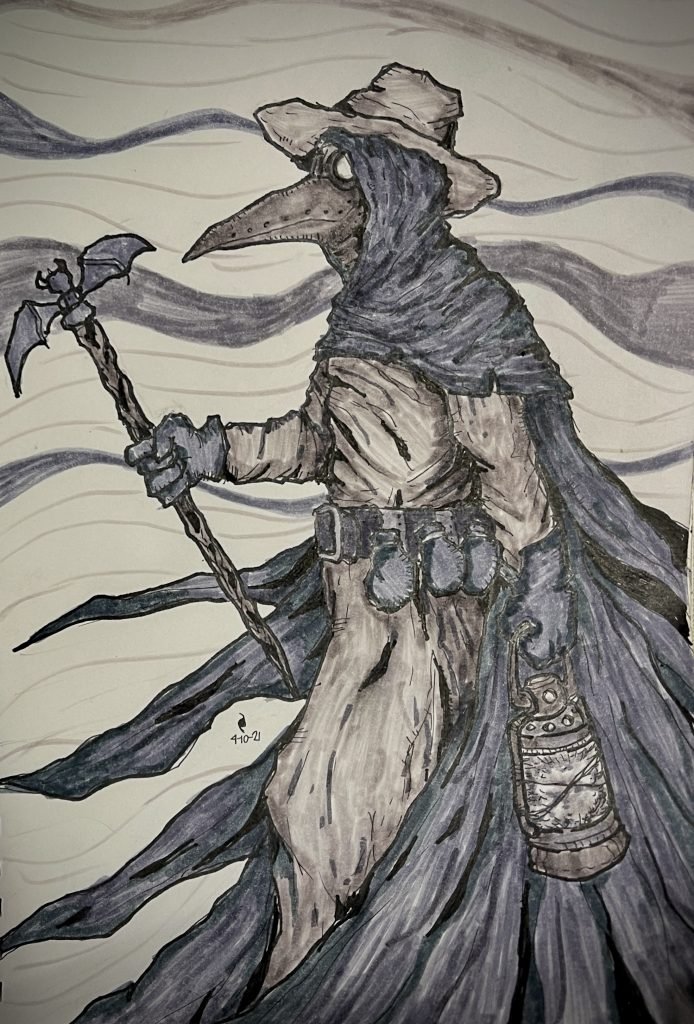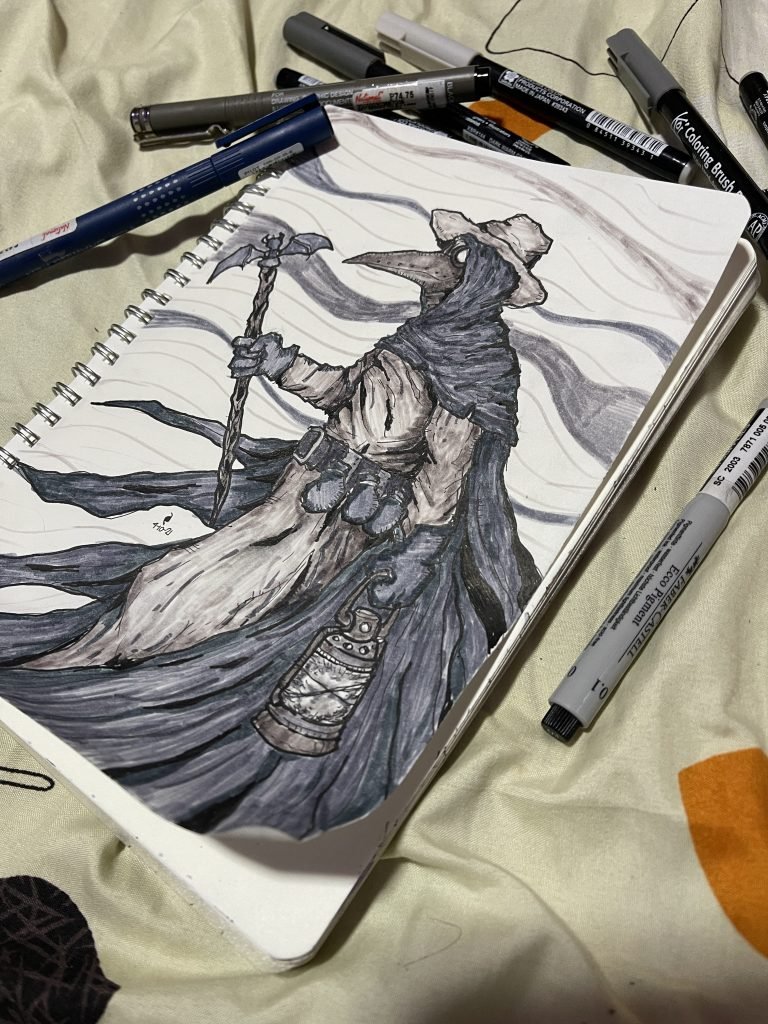
And I get to draw a Plague Doctor, using my Faber Castell and Artline Pens. Shaded with Koi brush pens.
i am always intrigued by the image of Plague Doctors. They were always a symbol of horror instead of healers. I always see them in scary flicks. My latest encounter with this is in The Irregulars, a supernatural series, pretty well done. I’ll be covering a review here soon. One quote though that really stuck with me is this:
Nothing is more foul than the devil…
The Irregulars
What is a Plague Doctor?
A plague doctor was a physician who treated victims of the bubonic plague during epidemics. These physicians were hired by cities to treat infected patients regardless of income, especially the poor that could not afford to pay. Plague doctors are often depicted in Halloween costumes and seen as a symbol of death and disease.
Plague doctors had a mixed reputation, with some citizens seeing their presence as a warning to leave the area. Some plague doctors were said to charge patients and their families additional fees for special treatments or false cures. In many cases these “doctors” were not experienced physicians or surgeons; instead, being volunteers, second-rate doctors, or young doctors just starting a career. In one case, a plague doctor was a fruit salesman before his employment as a physician. Plague doctors rarely cured patients; instead serving to record death tolls and the number of infected people for demographic purposes.
In France and the Netherlands, plague doctors often lacked medical training and were referred to as “empirics.” Plague doctors were known as municipal or “community plague doctors”, whereas “general practitioners” were separate doctors and both might be in the same European city or town at the same time.
Origin of the Plague Doctors
According to Michel Tibayrenc’s Encyclopedia of Infectious Diseases, the first mention of the iconic plague doctor is found during the 1619 plague outbreak in Paris, in the written work of royal physician Charles de Lorme, serving King Louis XIII of France at the time. After De Lorme, German engraver Gerhart Altzenbach published a famous illustration in 1656, which publisher Paulus Fürst’s iconic Doctor Schnabel von Rom is based upon. In this satirical work Fürst describes how the doctor does nothing but terrify people and take money from the dead and dying.
The city of Orvieto hired Matteo fu Angelo in 1348 for four times the normal rate of a doctor of 50-florin per year. Pope Clement VI hired several extra plague doctors during the Black Death plague to tend to the sick people of Avignon. Of 18 doctors in Venice, only one was left by 1348: five had died of the plague, and 12 were missing and may have fled.
What’s with the Creepy Outfit?
Some plague doctors wore a special costume consisting of an ankle-length overcoat and a bird-like beak mask, often filled with sweet or strong-smelling substances (commonly lavender), along with gloves, boots, a wide-brimmed hat, and an outer over-clothing garment. However, the costume was not worn by all medieval and early modern physicians studying and treating plague patients.
The typical mask had glass openings for the eyes and a curved beak shaped like a bird’s beak with straps that held the beak in front of the doctor’s nose. The mask had two small nose holes and was a type of respirator which contained aromatic items. The beak could hold dried flowers (including roses and carnations), herbs (including lavender and peppermint), camphor, or a vinegar sponge, as well as juniper berry, ambergris, cloves, labdanum, myrrh, and storax. The purpose of the mask was to keep away bad smells, known as miasma, which were thought to be the principal cause of the disease. Doctors believed the herbs would counter the “evil” smells of the plague and prevent them from becoming infected.
The wide-brimmed leather hat indicated their profession, and they used wooden canes in order to point out areas needing attention and to examine patients without touching them. The canes were also used to keep people away, to remove clothing from plague victims without having to touch them, and to take a patient’s pulse.
And there is a Contract for being a Plague doctor
A plague doctor’s contract was an agreement between a town’s administrators and a doctor to treat bubonic plague patients. These contracts are present in European city archives. Their contractual responsibility was to treat plague patients, and no other type of patient, to prevent spreading the disease to the uninfected. A plague doctor had to serve a long quarantine after seeing a plague patient. The doctor was regarded as a “contact” who by agreement had to live in isolation to be quarantined.

Comments are closed.